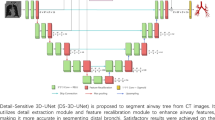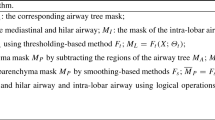Abstract
Purpose:
Bronchoscopic intervention is a widely used clinical technique for pulmonary diseases, which requires an accurate and topological complete airway map for its localization and guidance. The airway map could be extracted from chest computed tomography (CT) scans automatically by airway segmentation methods. Due to the complex tree-like structure of the airway, preserving its topology completeness while maintaining the segmentation accuracy is a challenging task.
Methods:
In this paper, a long-term slice propagation (LTSP) method is proposed for accurate airway segmentation from pathological CT scans. We also design a two-stage end-to-end segmentation framework utilizing the LTSP method in the decoding process. Stage 1 is used to generate a coarse feature map by an encoder–decoder architecture. Stage 2 is to adopt the proposed LTSP method for exploiting the continuity information and enhancing the weak airway features in the coarse feature map. The final segmentation result is predicted from the refined feature map.
Results:
Extensive experiments were conducted to evaluate the performance of the proposed method on 70 clinical CT scans. The results demonstrate the considerable improvements of the proposed method compared to some state-of-the-art methods as most breakages are eliminated and more tiny bronchi are detected. The ablation studies further confirm the effectiveness of the constituents of the proposed method and the efficacy of the framework design.
Conclusion:
Slice continuity information is beneficial to accurate airway segmentation. Furthermore, by propagating the long-term slice feature, the airway topology connectivity is preserved with overall segmentation accuracy maintained.






Similar content being viewed by others
References
Higgins WE, Cheirsilp R, Zang X, Byrnes P (2015) Multimodal system for the planning and guidance of bronchoscopy. In: medical imaging 2015: image-guided procedures, robotic interventions, and modeling, international society for optics and photonics, p 941508. https://doi.org/10.1117/12.2077242
Mehta AC, Hood KL, Schwarz Y, Solomon SB (2018) The evolutional history of electromagnetic navigation bronchoscopy: state of the art. Chest 154(4):935–947. https://doi.org/10.3410/f.734168763.793551452
Shen M, Gu Y, Liu N, Yang GZ (2019) Context-aware depth and pose estimation for bronchoscopic navigation. IEEE Robot Autom Lett 4(2):732–739. https://doi.org/10.1109/lra.2019.2893419
Fabijańska A (2009) Two-pass region growing algorithm for segmenting airway tree from mdct chest scans. Comput Med Imaging Graph 33(7):537–546. https://doi.org/10.1016/j.compmedimag.2009.04.012
Chen F, Gao J (2018) An automatic multiscale region growing segmentation in medical image based on slic and 2d otsu. In: Proceedings of the 3rd international conference on intelligent information processing, pp 58–62. https://doi.org/10.1145/3232116.3232126
Aykac D, Hoffman EA, McLennan G, Reinhardt JM (2003) Segmentation and analysis of the human airway tree from three-dimensional x-ray ct images. IEEE Trans Med Imaging 22(8):940–950. https://doi.org/10.1109/tmi.2003.815905
Juarez AGU, Tiddens HA, de Bruijne M (2018) Automatic airway segmentation in chest ct using convolutional neural networks. Image analysis for moving organ, breast, and thoracic images. Springer, Berlin, pp 238–250
Qin Y, Gu Y, Zheng H, Chen M, Yang J, Zhu YM (2020) Airwaynet-se: a simple-yet-effective approach to improve airway segmentation using context scale fusion. In: 2020 IEEE 17th international symposium on biomedical imaging (ISBI), IEEE, pp 809–813. https://doi.org/10.1109/isbi45749.2020.9098537
Qin Y, Zheng H, Gu Y, Huang X, Yang J, Wang L, Zhu YM (2020) Learning bronchiole-sensitive airway segmentation cnns by feature recalibration and attention distillation. In: international conference on medical image computing and computer-assisted intervention, Springer, pp 221–231. https://doi.org/10.1007/978-3-030-59710-8_22
Zhang M, Yu X, Zhang H, Zheng H, Yu W, Pan H, Cai X, Gu Y (2021) Fda: Feature decomposition and aggregation for robust airway segmentation. Domain Adaptation and Representation Transfer, and Affordable Healthcare and AI for Resource Diverse Global Health. Springer, Berlin, pp 25–34
Garcia-Uceda A, Selvan R, Saghir Z, Tiddens HA, de Bruijne M (2021) Automatic airway segmentation from computed tomography using robust and efficient 3-d convolutional neural networks. Sci Rep 11(1):1–15. https://doi.org/10.1038/s41598-021-95364-1
Ronneberger O, Fischer P, Brox T (2015) U-net: convolutional networks for biomedical image segmentation. In: international conference on medical image computing and computer-assisted intervention, Springer, pp 234–241
Çiçek Ö, Abdulkadir A, Lienkamp SS, Brox T, Ronneberger O (2016) 3d u-net: learning dense volumetric segmentation from sparse annotation. In: international conference on medical image computing and computer-assisted intervention, Springer, pp 424–432. https://doi.org/10.1007/978-3-319-46723-8_49
Qin Y, Chen M, Zheng H, Gu Y, Shen M, Yang J, Huang X, Zhu YM, Yang GZ (2019) Airwaynet: a voxel-connectivity aware approach for accurate airway segmentation using convolutional neural networks. In: international conference on medical image computing and computer-assisted intervention, Springer, pp 212–220. https://doi.org/10.1007/978-3-030-32226-7_24
Juarez AGU, Selvan R, Saghir Z, de Bruijne M (2019) A joint 3d unet-graph neural network-based method for airway segmentation from chest cts. In: international workshop on machine learning in medical imaging, Springer, pp 583–591. https://doi.org/10.1007/978-3-030-32692-0_67
Pan X, Shi J, Luo P, Wang X, Tang X (2018) Spatial as deep: Spatial cnn for traffic scene understanding. In: thirty-second AAAI conference on artificial intelligence
Hochreiter S, Schmidhuber J (1997) Long short-term memory. Neural Comput 9(8):1735–1780
Milletari F, Navab N, Ahmadi SA (2016) V-net: fully convolutional neural networks for volumetric medical image segmentation. In: 2016 fourth international conference on 3D vision (3DV), IEEE, pp 565–571. https://doi.org/10.1109/3dv.2016.79
Lo P, Van Ginneken B, Reinhardt JM, Yavarna T, De Jong PA, Irving B, Fetita C, Ortner M, Pinho R, Sijbers J (2012) Extraction of airways from ct (exact’09). IEEE Trans Med Imaging 31(11):2093–2107
Wang C, Hayashi Y, Oda M, Itoh H, Kitasaka T, Frangi AF, Mori K (2019) Tubular structure segmentation using spatial fully connected network with radial distance loss for 3d medical images. In: international conference on medical image computing and computer-assisted intervention, Springer, pp 348–356. https://doi.org/10.1007/978-3-030-32226-7_39
Acknowledgements
Yun Gu is sponsored by Shanghai Sailing Program (20YF1420800), National Nature Science Foundation of China (No.62003208) and Shanghai Municipal of Science and Technology Project (Grant No.20JC1419500), Science and Technology Commission of Shanghai Municipality under Grant 20DZ2220400.
Author information
Authors and Affiliations
Corresponding author
Ethics declarations
Conflict of Interest
The authors declare that they have no conflict of interest.
Ethical approval
This article does not contain any studies with human participants or animals performed by any of the authors.
Informed consent
The study conducted experiments based on publicly available datasets.
Additional information
Publisher's Note
Springer Nature remains neutral with regard to jurisdictional claims in published maps and institutional affiliations.
Rights and permissions
About this article
Cite this article
Wu, Y., Zhang, M., Yu, W. et al. LTSP: long-term slice propagation for accurate airway segmentation. Int J CARS 17, 857–865 (2022). https://doi.org/10.1007/s11548-022-02582-7
Received:
Accepted:
Published:
Issue Date:
DOI: https://doi.org/10.1007/s11548-022-02582-7




